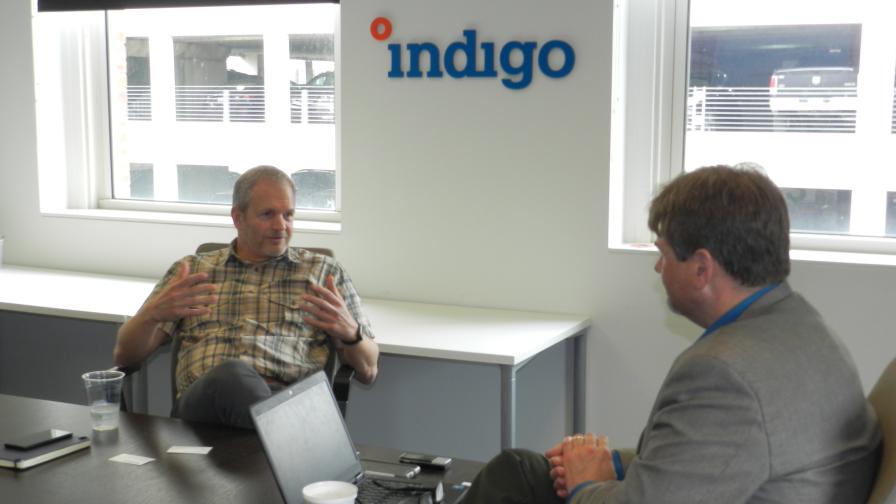Indigo Ag Is Betting on the De-Commoditization of Agriculture. Can It Work?

Indigo Ag CEO David Perry (left) shares his company’s vision with PrecisionAg Group Editor Paul Schrimpf.
Few stakeholders within agriculture would quibble with the notion that commodity crop production has largely evolved into a race to the bottom, and sitting square in the deepest part of the trough is the commodity crop producer.
For the better part of a century, farming moved from farmers feeding themselves and, perhaps, a nearby region of the country to feeding the entire world. All made possible by amazing technological and logistical advancements across the entire food production spectrum, and all designed for maximum crop production.
Today, overproduction, low crop prices, and rising production costs once considered a merely a part of the cycle of pain producers must endure feel like they may never end. Something has to change, right? Is the pendulum that’s been lodged so firmly to the side of “commoditization” destined to swing back in the not-too-distant future?

Indigo Ag CEO David Perry
The folks at Indigo Ag are betting on a significant shift in market approach to commodity crop production, driven by downstream demand from both consumers and food companies, and has set about the business of setting the table for a more demand-based approach. And they are getting plenty of attention both inside and outside of agriculture. I recently traveled to the Memphis, TN, U.S. headquarters to sit down with Indigo’s CEO David Perry and COO Rachel Raymond to discuss the myriad technological tentacles that that company has constructed, and how they are designed to intertwine to take advantage of what they see as the assured de-commoditizing of agriculture.
MORE BY PAUL SCHRIMPF
‘Future of Food’ Panel Will Deliver Compelling Close to 2022 VISION Conference in January
CoBank Report Asserts Precision Services are Essential to Future of U.S. Ag Retail
Market Disruption Makes the Time Right
Why is now the time to go all in? Perry rattles off the key drivers of coming ag market disruption that agriculture has heard before: Fresh water consumption, greenhouse gas emissions, soil loss, pesticide residues, and nutrient intrusion in watersheds. All are relatively well-known issues, but relatively little progress has been made on them.
“As long as food is treated like a commodity, then farmers don’t get paid for quality and production methods that embrace sustainability,” says Perry. “So, what you see now is what you would expect to see – farmers focus pretty much exclusively on volume because that is what they get paid for.”
Indigo predicts, and is banking on, agriculture embracing systemic changes based on what it sees as consumer, food processor, and regulatory demands that will pay producers on quality, sustainability, and more “grown to order” crops. To this end, the company is working to put myriad systems in place that allow commodity crop growers to find alternative suppliers and value-add partners.
Its recent deal tying rice farmers directly to Anheuser-Busch provides the brewer with evidence of sustainable production and a reliable supply of a key raw material in the production of its beer. It also serves as a window into what’s possible with other crops and other partners.
Perry and Raymond understand the transformation that will be necessary, and have set about the task of creating programs and structures around which commodity farmers, input suppliers, and food manufacturers can congregate and find partners.
Where they see evidence for future success is the interest and support that Indigo Marketplace is receiving through its first year of operation. Marketplace is designed to match commodity demand with available acreage through sign-ups on both sides – farmers enroll available acreage as supply, and downstream companies create demand by listing their crop needs. “We are getting buyers of every type from flour for wheat bread to corn for chickens, from soybean crush to breweries and consumer packaged goods companies,” says Perry. Indigo reports that volume in excess of $11 billion, and demand of more than $31 billion on its website. “Marketplace is the fastest growing thing I’ve ever been associated with in my 22 years of running tech companies,” he adds.
Around the Marketplace are systems to support the transaction, including grain sampling, product delivery, and payment directly from Indigo. Many in its employee base, now topping 900, are acting to help connect the dots between farmers, buyers, transporters, and other stakeholders to ensure the process is working as smoothly as possible. “We have spent an enormous amount of effort to put the pieces in place so that we could have the capability to deliver on the vision,” says Perry.
Important Questions About Indigo Ag’s Future
This is all fascinating, and the commitment from my brief interviews and walk around the office appears to be real. But only time will answer important questions about the future.
- Can Indigo’s effort be sustained? Agriculture is often exuberant in the first year of a compelling idea, and as long as the amount of skin in the game is low, support can appear high. What the Marketplace support definitely says is that farmers are exhausted with the state of the commodity crop market, and there is interest in at least taking an initial step toward contract farming from downstream players. How the second year plays out will be an important indicator of the future, and how serious both sides are about this model of de-commoditization.
- Will consumer demand truly grow? Pull-through demand from the consumer when it comes to commodity grains certainly exists but will need to grow pretty substantially to sustain the Indigo model. Perhaps as companies like Walmart, with its Project Gigaton and the effect on its supply partners, or other consumer retailers looking to create a consumer niche like Amazon-Whole Foods, will spark demand.
- How does Indigo make money? There wasn’t a clear answer to this question, other than the assumption that the multiple-level system as fully visualized and manifested would provide revenue opportunities for the company.
In the end, I see this as a very heavy lift. But frankly, I have to agree that moving the market in the direction of more value for farmers and more opportunities to generate revenue for farmers doing premium work is very appealing. Whether or not it becomes a real, value-creating platform, I hope it inspires movement in the direction of improving the options that commodity producers have in the future.










